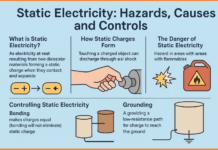In recent years, technological advancements have significantly impacted various industries, and firefighting is no exception. The emergence of robotic firefighting systems marks a revolutionary step towards enhancing the efficiency and safety of firefighting operations. These cutting-edge machines are designed to navigate through hazardous environments, combat fires, and assist human firefighters in their crucial tasks. This article we will discuss the key features, benefits, and potential uses of robotic firefighting systems.
Contents
Features of Robotic Firefighting Systems:
- Autonomous Navigation: Robotic firefighting systems are equipped with advanced sensors and artificial intelligence algorithms that enable autonomous navigation through complex and dangerous environments. This feature allows these robots to reach areas that may be too perilous for human firefighters.
- Fire Detection and Monitoring: Utilizing state-of-the-art sensors such as infrared cameras and gas detectors, robotic firefighting systems can swiftly detect the presence of fire and monitor its progression. This early detection is crucial for timely intervention and preventing the escalation of the fire.
- Fire Suppression Mechanisms: These robots are equipped with various firefighting mechanisms, including water cannons, foam dispensers, and even fire-retardant materials. They can effectively combat fires by deploying these resources with precision, minimizing damage and risk to human life.
- Communication Systems: Robotic firefighting systems are often equipped with communication systems that allow them to collaborate seamlessly with human firefighters. This ensures coordinated efforts in tackling the fire and enhances overall operational efficiency.
- Remote Operation: In situations where direct human intervention is too risky, these robots can be operated remotely. This capability allows firefighters to assess the situation from a safe distance and make informed decisions about the deployment of resources.
Benefits of Robotic Firefighting Systems:
- Enhanced Safety: One of the primary advantages of robotic firefighting systems is their ability to operate in hazardous environments without putting human lives at risk. They can enter burning buildings, navigate through smoke-filled areas, and withstand extreme temperatures.
- Quicker Response Times: Autonomous navigation and early fire detection enable these robots to respond to incidents swiftly. Reduced response times are critical in firefighting, as they contribute to minimizing property damage and increasing the chances of successful containment.
- 24/7 Availability: Unlike human firefighters, robotic systems do not require rest. They can operate continuously, providing round-the-clock surveillance and intervention capabilities.
- Cost-Effectiveness: While the initial investment in robotic firefighting systems may be substantial, their long-term cost-effectiveness is notable. The ability to prevent extensive property damage and the potential to save lives outweigh the initial expenses.
Potential Uses of Robotic Firefighting Systems:
- Industrial Fires: Robotic firefighting systems are well-suited for industrial settings where fires can be complex and challenging to handle. Their ability to navigate through intricate machinery and hazardous materials makes them invaluable in such environments.
- Urban Search and Rescue: In urban search and rescue operations, these robots can enter collapsed buildings, search for survivors, and even deliver essential supplies. Their agility and autonomous capabilities make them essential tools for first responders in disaster-stricken areas.
- Wildfire Management: In areas prone to wildfires, robotic firefighting systems can be deployed to monitor and combat fires in remote locations. Their autonomous nature allows them to cover large areas efficiently.
Robotic firefighting systems represent a significant leap forward in the realm of firefighting technology. As these systems continue to evolve, their integration with traditional firefighting methods is likely to become more seamless, offering enhanced safety and efficiency in the face of emergencies. The collaboration between human firefighters and their robotic counterparts holds great promise for the future of firefighting, ushering in an era where the combination of human expertise and technological innovation can better protect lives and property from the devastating effects of fires.
History of robotic fire fighting
The history of robotic firefighting dates back several decades, with advancements driven by a growing need to enhance firefighting capabilities in complex and hazardous situations. The evolution of robotic firefighting systems can be traced through key milestones that highlight the gradual integration of robotics and artificial intelligence into firefighting operations.
- Early Remote-Controlled Vehicles (1950s-1980s): The earliest attempts at introducing robotics into firefighting involved remote-controlled vehicles designed to navigate hazardous environments. These vehicles were often simple in design and remotely operated by human operators. While rudimentary compared to modern robotic systems, they paved the way for future developments in the field.
- NASA’s Robotex (1980s): In the 1980s, NASA developed a robotic system called Robotex for firefighting purposes. Robotex was equipped with a water cannon and designed to be remotely operated in situations deemed too dangerous for human firefighters. Although not widely adopted, it demonstrated the potential of using robotics in firefighting applications.
- DARPA’s Grand Challenge (2004): While not directly related to firefighting, the Defense Advanced Research Projects Agency (DARPA) Grand Challenge in 2004 stimulated interest in autonomous vehicle technology. The success of this challenge in developing self-driving vehicles inspired researchers to explore autonomous systems for various applications, including firefighting.
- SAFFiR (2014): The Shipboard Autonomous Firefighting Robot (SAFFiR) was developed by the U.S. Navy in collaboration with researchers at Virginia Tech. SAFFiR was designed to autonomously navigate ships and combat fires on board. It marked a significant step towards developing robots capable of operating in dynamic and unstructured environments.
- TAF 20 (2017): In 2017, the Tokyo Fire Department introduced the TAF 20 firefighting robot. This robot was equipped with thermal imaging cameras and a water cannon, allowing it to assess and combat fires autonomously. The TAF 20 was designed to enter buildings, locate the source of the fire, and suppress it with minimal human intervention.
- Colossus (2019): Colossus, developed by the French company Shark Robotics, gained attention in 2019 during the Notre-Dame Cathedral fire in Paris. Colossus, an unmanned ground vehicle, was deployed to assist firefighters by carrying hoses and other equipment into the heart of the blaze. Its role in the Notre-Dame incident highlighted the potential of robotic systems in supporting human firefighting efforts.
- Current Developments (2020s): In recent years, advancements in robotics, artificial intelligence, and sensor technologies have accelerated the development of robotic firefighting systems. These systems now feature enhanced autonomy, sophisticated fire detection capabilities, and more effective firefighting mechanisms. Collaborative efforts between academia, industry, and firefighting agencies continue to drive innovation in this field.
The history of robotic firefighting reflects a gradual shift from remote-controlled vehicles to autonomous and intelligent systems capable of operating in diverse and challenging environments. As technology continues to progress, the integration of robotics into firefighting practices is expected to become more widespread, ultimately improving the effectiveness and safety of firefighting operations.





